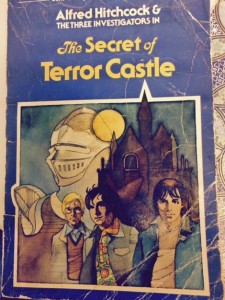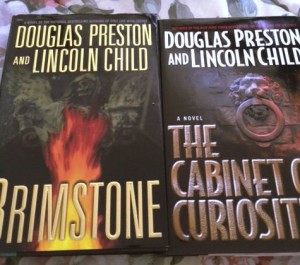Why Found-Again? Like many bookish kids of a certain time period, I cut my teeth on Nancy Drew novels (I was hard on books, so if you could see them, you’d think I meant that literally) and the Hardy Boys, supplemented by the occasional T.A.C.K. puzzle-mystery collection. But my favorites were the Three Investigators mysteries, so this week I’m taking a look at the first book in that series.

The Premise: Inquisitive youngsters Pete, Bob and Jupiter (…yeah) start a detective agency by organizing Jupiter’s family junkyard into an office and a series of brilliant secret passages and by blackmailing Alfred Hitchcock—clearly the best way to do almost anything. For their first case, the three look into the mystery of a vanished old movie star and his spooky mansion. Along the way they have to cope with rivals from school, a menacing ex-manager, and mounting evidence that the darned house may actually be haunted.
I mean it in the best possible way when I say that this one’s a Scooby-Doo episode—a connection I never made when I was watching the Scooby Gang as a kid: maybe I thought everything was like that when I was eight. As explained Gothic goes, though, it’s quite atmospheric, with no amount of explanation quite able to quell the characters’ fright.
The thing about mystery novels for kids is that they center intelligence as the most important quality the character can have—at least, that’s my theory for why I loved these books so much and idolized two of the three main characters. I have clear memories of begging my father to help me move old farm equipment around to make secret passages like The Three Investigators (he refused, thus passively saving me from a series of encounters with various poisonous snakes).
The series is not without its own mysteries, though. Unlike Nancy Drew, who seems to be forever college-aged, I can’t quite figure out how old Bob, Pete and Jupe are supposed to be. They’re too young to drive, but their kid nemesis is not, which makes me think they can’t be younger than 12. And shouldn’t their kid nemesis be interested in girls by now?
The Verdict: This was a surprisingly fun reread, despite being written in what might be called Kids’ Adventurese, with the bowdlerized swearwords and the wholesome protagonists. I suspect a few more of these will be added to the Found-Again archive as time goes on: at the very least there’s still my favorite, The Singing Serpent, yet to go.
Might go well with: popcorn, a glass of milk, envy that you never owned a printing press when you were approximately twelve years old.
Next time: It’s Highlander: Endgame, and probably the end of me writing about Connor MacLeod for a while.

